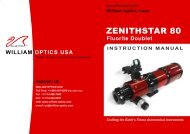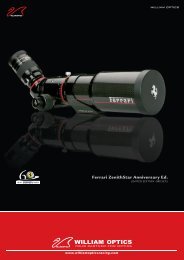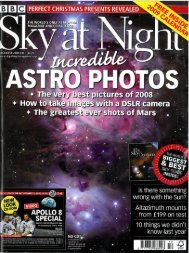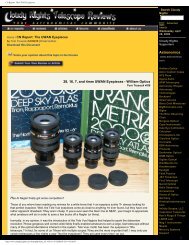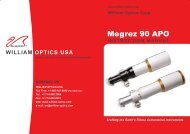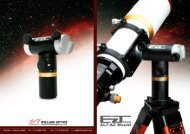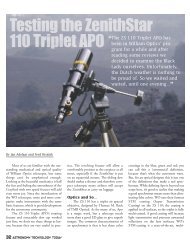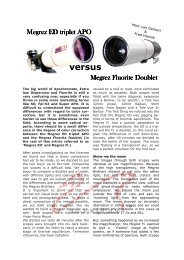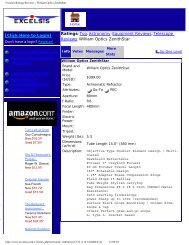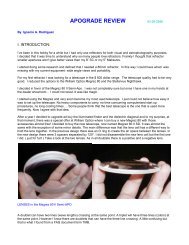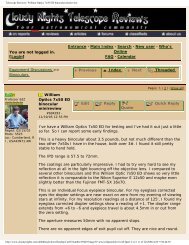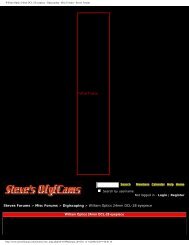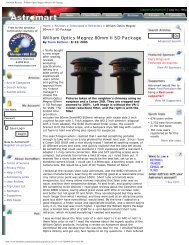Astromart Reviews - William Optics FLT110mm f7 TMB designed ...
Astromart Reviews - William Optics FLT110mm f7 TMB designed ...
Astromart Reviews - William Optics FLT110mm f7 TMB designed ...
You also want an ePaper? Increase the reach of your titles
YUMPU automatically turns print PDFs into web optimized ePapers that Google loves.
<strong>Astromart</strong> <strong>Reviews</strong> - <strong>William</strong> <strong>Optics</strong> <strong>FLT110mm</strong> <strong>f7</strong> <strong>TMB</strong> <strong>designed</strong> triplet and matching field flattener<br />
One can see a few •icks?in the outer ring of the pattern. This may have been caused by the producer clamping<br />
the lens on 3 points during production, or even from lens cell effects. Given the effect is so minor and does not<br />
really give the impression of pinched optics, I did not bother to dig deeper into possible causes. For the<br />
perfectionists amongst us, this may lead (being careful here) to bumps or tiny spikes in the halo around stars<br />
when using image histogram stretching with DDP processing on long exposure images. But if you would use a<br />
DSLR or one of the blooming CCD most likely they will give more artefacts around stars on their own already.<br />
All images are the result of a stack of a few AVI movies in prime focus of the FLT110, made with a DMK 21AF04<br />
firewire camera.<br />
For the visual observations, we used similar eyepieces from <strong>TMB</strong>, and both equipped with a 1.8x <strong>TMB</strong> ED Barlow<br />
to obtain higher magnifications. The three of us had a very hard time to detect differences between the Orion<br />
Nebula trapezium stars and immediate vicinity.<br />
Both scopes show clean sharp stars with nice hints of real colour. One observer noticed a slight contrast<br />
advantage for the <strong>TMB</strong> 105, but not by all that much. I did not detect significant contrast differences on the<br />
nebula, nor any difference in the sharpness and clarity of the Trapezium stars.<br />
Saturn under good seeing was very nice in both scopes, with no differences to be noticed on the Cassini division,<br />
nor in the belts on the planet. We knew about the slight optical imperfections upfront, so we really looked very<br />
carefully to spot effects from it, but without success. Saturn was slightly brighter in the FLT110, showing 0.5cm<br />
more aperture. I did have the impression the equatorial belt on Saturn may have been slightly darker and give<br />
the idea of a bit more contrast in the <strong>TMB</strong> 105, but I wouldn• place a bet on it, as it can be related to the slightly<br />
brighter overall image. Both telescopes showed the subtle colour hues on Saturn.<br />
All this really makes evident how critical a star test can be. Everything shows, even marks that have in practice<br />
little influence on the end image.<br />
The clever design of the <strong>TMB</strong> 105mm dew shield (seen on the picture with Jorg) did prove its use in the field.<br />
Thanks to the tiny front baffle in the dew shield, the <strong>TMB</strong> 105mm remained dew free during the night with lots of<br />
moisture in the air. The FLT110 has no such front baffle and needed a Kendrick dew heater after a few hours.<br />
Jorg Versluys is seen carrying both the <strong>TMB</strong> 105mm and the WO FLT110. Notice the heavier looks of the <strong>TMB</strong><br />
105, but it is not really that much heavier than the FLT110.<br />
http://www.astromart.com/articles/article.asp?article_id=523 (6 of 19)1/6/2007 10:54:28 AM



